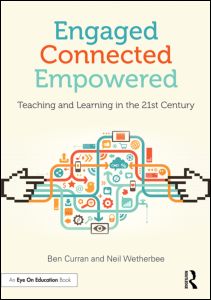How to Shift to 21st Century Classrooms
Engaged, Connected, Empowered: Teaching and Learning in the 21st Century
By Ben Curran and Neil Wetherbee
(Routledge/Eye on Education, 2014 – Learn more)

Ben Curran and Neil Wetherbee identify five major shifts required for schools to provide students with the skills they will need in the 21st century: (1) from consumption to production, (2) from local to global, (3) from searching to filtering, (4) from standardized to student centered, and (5) from isolated to connected.
These shifts dovetail with those identified by other future-thinking groups, and the book is sufficiently referenced throughout.
 A clear structure for easy study
A clear structure for easy study
The layout of the book is easy to follow. Under each of the five major shifts there are three chapters, including an introduction, a focus on implementation, and author anecdotes. The introduction of each section gives a brief overview of the shift.
The implementation chapter then gives specifics of how teachers can bring about the shift in their classrooms, including steps for the novice, intermediate, or expert level.
Finally, the anecdotal chapters contain specific examples of how the shift has been implemented in the authors’ classrooms.
Projects go global
The suggestions in the implementation chapters are broken down into doable steps, with links provided to resources or sites to help with the specific ideas. For instance, in the implementation chapter for the localized vs. global section, the authors’ suggest using projects that are global in nature. They discuss five potential sources for finding global projects along with the links, and then suggest going global with your classroom projects and work, discussing four options for doing so and providing the links for these options.
Searching becomes filtering
In the chapters on shifting from searching to filtering, Curran and Wetherbee give some great tips that will help teachers move students from general searches (picking the first site that pops up) to search returns that are better focused on what students are looking for. Then they give suggestions on how teachers can help students take these refined searches and filter them further. In the process, teachers are leading their students to develop important and lasting skills that will make them more searchers throughout their lives. Teachers may find some of these tips helpful for their own searches.
Teachers connect too
The final section of the book – shifting from isolated to connected – focuses more on teacher learning and development. In this section the authors make a compelling argument for teachers to use social bookmarking, Twitter, blogging and RSS feeds, both to help teachers keep up with all the information and resources they are gathering and to build their PLNs (Professional Learning Networks).
Curran and Wetherbee provide enough specific suggestions to really get you started in the process, including a number of educational Twitter chats and hashtags to follow, some of which they have created themselves. They have also established a Facebook page where you can “interact with the authors and find ongoing content for this book.”
Engaged, Connected, Empowered is a handy book to help teachers at all levels (novice to expert, and kindergarten to grade 12) successfully move their students through the transitions: to collaboration, filtering sources and using primary sources, creating products to be shared globally, and using technology to accomplish this and more, to meet the needs of the 21st Century.
Laura Von Staden is a Special Education Middle School Teacher in Tampa, Florida. She serves on numerous committees both at her school and within her district and works closely with the local university where she is a Professional Practice Partner and a master mentor. Dr. Von Staden also facilitates both online and face-to-face Professional Development within her district.


































